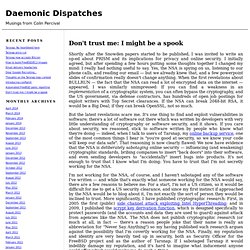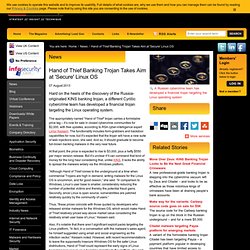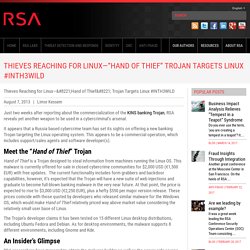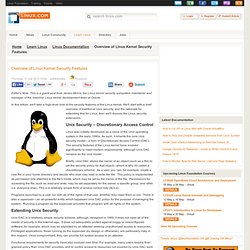

OWASP. Don't trust me: I might be a spook. Shortly after the Snowden papers started to be published, I was invited to write an op-ed about PRISM and its implications for privacy and online security.

I initially agreed, but after spending a few hours putting some thoughts together I changed my mind: I really had nothing useful to say. Yes, the NSA is spying on us, listening to our phone calls, and reading our email — but we already knew that, and a few powerpoint slides of confirmation really doesn't change anything. When the first revelations about BULLRUN — the fact that the NSA can read a lot of encrypted data on the internet — appeared, I was similarly unimpressed: If you can find a weakness in an implementation of a cryptographic system, you can often bypass the cryptography, and the US government, via defense contractors, has hundreds of open job postings for exploit writers with Top Secret clearances. If the NSA can break 2048-bit RSA, it would be a Big Deal; if they can break OpenSSL, not so much.
CWE - Common Weakness Enumeration. Nmap Announce: Nmap 6.40 Released! New scripts, new signatures, better performance! Pdf/1301.6356.pdf. Lafo.ssw.uni-linz.ac.at/papers/2013_JVMLanguageSummit_OneVMToRuleThemAll.pdf. Hand of Thief Banking Trojan Takes Aim at 'Secure' Linux OS. The appropriately named “Hand of Thief” trojan carries a formidable price tag – it’s now for sale in closed cybercrime communities for $2,000, with free updates, according to RSA cyber-intelligence expert Limor Kessem.

The functionality includes form-grabbers and backdoor capabilities for now, but it’s expected that the trojan will have a new suite of web injections soon, she said. And so, it should graduate to become full-blown banking malware in the very near future. At that point, the price is expected to rise to $3,000, plus a hefty $550 per major version release. But it’s unclear if it can command that kind of money for the long haul considering that, unlike KINS, it lacks the ability to spread the malware widely via the Windows platform. “Although Hand of Thief comes to the underground at a time when commercial Trojans are high in demand, writing malware for the Linux OS is uncommon, and for good reason,” she said. Thieves Reaching for Linux—"Hand of Thief" Trojan Targets Linux #INTH3WILD.
Just two weeks after reporting about the commercialization of the KINS banking Trojan, RSA reveals yet another weapon to be used in a cybercriminal’s arsenal.

It appears that a Russia based cybercrime team has set its sights on offering a new banking Trojan targeting the Linux operating system. This appears to be a commercial operation, which includes support/sales agents and software developer(s). Meet the “Hand of Thief” Trojan Hand of Thief is a Trojan designed to steal information from machines running the Linux OS. This malware is currently offered for sale in closed cybercrime communities for $2,000 USD (€1,500 EUR) with free updates.
The Trojan’s developer claims it has been tested on 15 different Linux desktop distributions, including Ubuntu Fedora and Debian. An Insider’s Glimpse RSA researchers have managed to obtain the malware builder as well as the server side source code, and a preliminary analysis reveals familiar functionalities of a banking Trojan. Control Panel Features. Krebs on Security. Kernel Sec Features. Editor's Note: This is a guest post from James Morris, the Linux kernel security subsystem maintainer and manager of the mainline Linux kernel development team at Oracle.

In this article, we'll take a high-level look at the security features of the Linux kernel. We'll start with a brief overview of traditional Unix security, and the rationale for extending that for Linux, then we'll discuss the Linux security extensions. Unix Security – Discretionary Access Control Linux was initially developed as a clone of the Unix operating system in the early 1990s.
Briefly, Unix DAC allows the owner of an object (such as a file) to set the security policy for that object—which is why it's called a discretionary scheme. Programs launched by a user run with all of the rights of that user, whether they need them or not. Extending Unix Security.